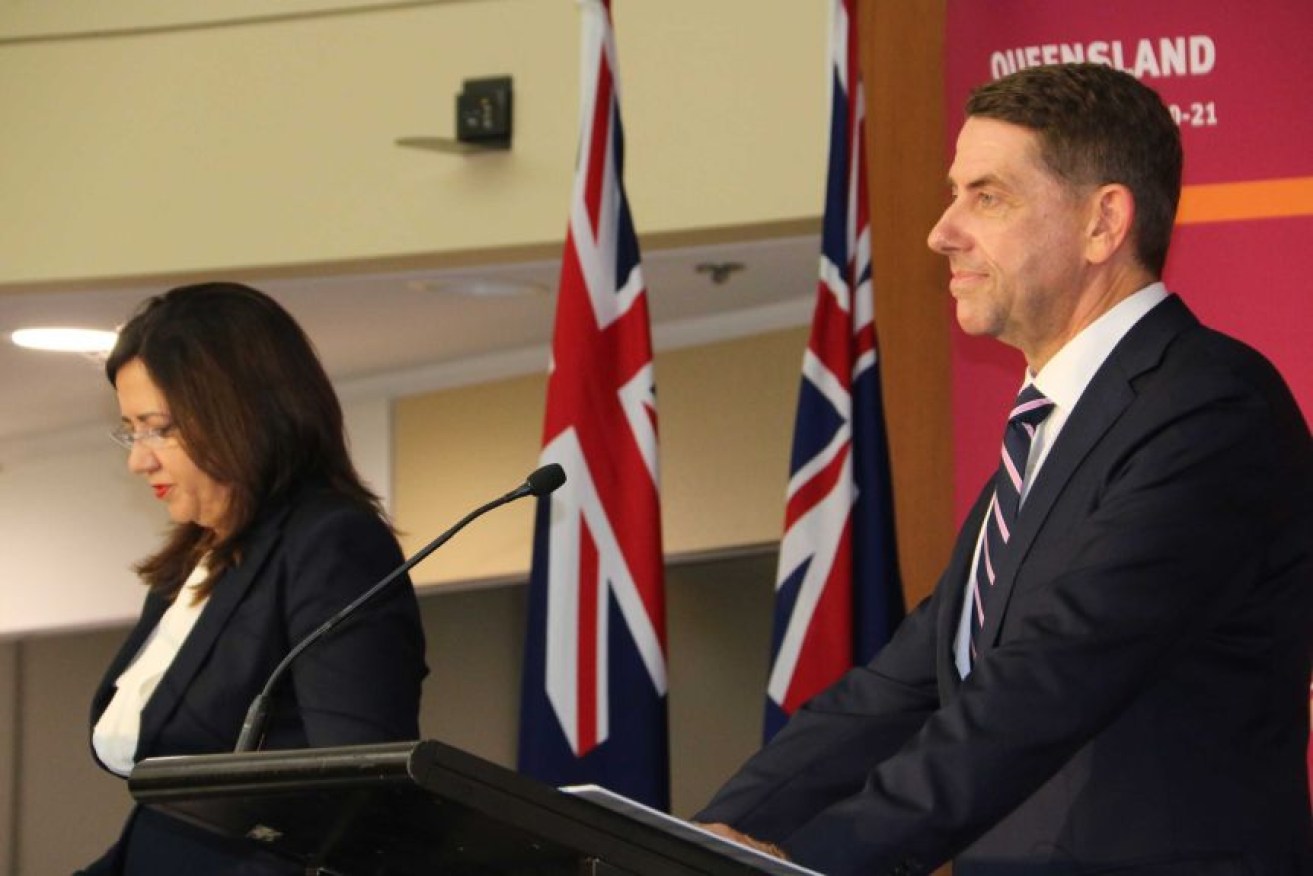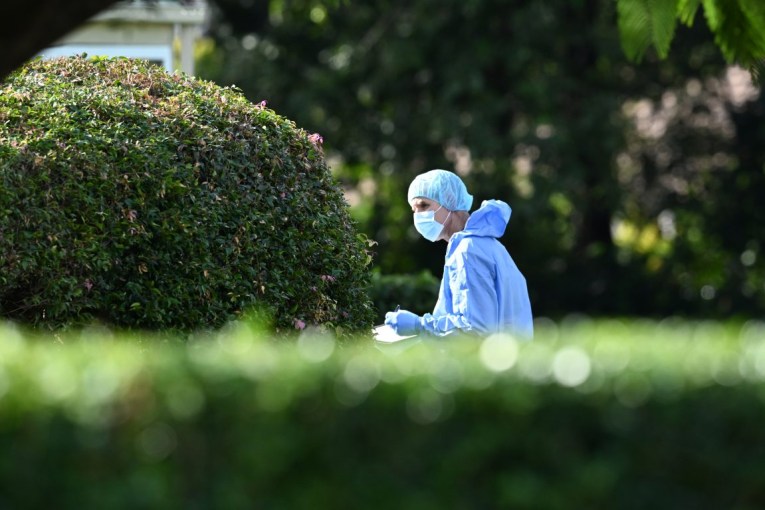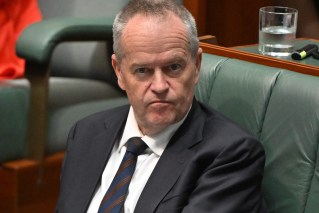Labor borrows big to keep Queensland going but there are limits
Treasurer Cameron Dick has handed down the long-awaited 2020-21 budget, revealing some interesting parallels with governments past and present.

Premier Annastacia Palaszczuk and Treasurer Cameron Dick detail the Queensland budget.
On the key economic indicators, Treasury now believes unemployment will peak this year at 7.5 per cent, before dropping back to 6.5 per cent, which is still above pre-pandemic trends.
The budget has been characterised as a jobs generator but it has come at a cost, with an operating deficit of $8.6 billion this year and the budget remaining in the red until at least 2023-24.
Borrowings will increase dramatically, as the government avoids cuts and austerity measures, hitting nearly $130 billion at the end of the forward estimates. Dick and Premier Annastacia Palaszczuk repeatedly said this was lower, on various measures, than NSW and Victoria.
Yet Queensland’s capital works budget of $56 billion over four years is still not as high as that delivered by the former Bligh Labor government in 2009-10 to drag Queensland out of the global financial crisis. At the time, debt was used only for infrastructure, however, under the third-term Palaszczuk government, short-term capital purchases are lower and there is a paucity of detail about future spending. The projected spend includes already includes a surge in Cross River Rail works.
Dick said the budget honoured Labor’s election commitments and provided more direct support to industries affected by the pandemic and recession. He appeared to suggest the capitals works program was appropriate given the economic and budgetary uncertainty.
Population growth will inevitably put more pressure on infrastructure, particularly in the urban southeast, and labour force figures that offset any jobs growth.
“As we restore the strength of the economy, and get back to fiscal strength in our budget, we will look, of course, to invest more,” Dick said.
Dick said he would need to consider whether Labor’s fiscal principles – primarily around the use of debt, and growth of the public service – were appropriate in a post-COVID environment. He acknowledged the extent of Queensland’s borrowings may draw the attention of ratings agencies.
“We cannot rule out the possibility that Queensland will also be put on negative outlook (like South Australia),” he said.
While Dick insisted Queensland’s focus was on jobs, NSW and Victoria are still expected to have lower unemployment rates.
“We’ve got more people moving here but we’ve got more people who want jobs,” Dick said.
“That’s a double-edged sword for Queensland.”
The capital works program is normally a key driver of jobs growth. When the 2009-10 budget was handed down, then Labor treasurer Andrew Fraser said Queensland was doing the “heavy lifting” with a program “aimed at the full force of the downturn delivered unto us from the global recession”.
The domestic economy has proved more resilient during the COVID-19 pandemic than analysts predicted, a fact reflected in the budget. However, the risk of a second wave of infections looms large, and Australia’s trade dispute with China is already impacting on Queensland and may not be reflected in the forecasts.
Queensland Premier Annastacia Palaszczuk refused to directly criticise China for the worsening trade dispute with Australia, nor the Morrison government for how it is being handled. While Treasury surprisingly predicted an improvement in relations, Palaszczuk said China would be discussed at the next National Cabinet meeting.
Palaszczuk also denied misleading voters about the scale of borrowings, saying the government had predicted deficits and ruled out public service cuts or austerity measures.
“The budget is no surprises, it’s there,” Palaszczuk told journalists.
“We went to the people of Queensland, they endorsed us.”
The budget also honours Labor’s commitment of no new or increased taxes, although the indexation rate is higher than CPI.
An early critic of the Budget was the Property Council, which described it as a missed opportunity.
Queensland executive director Chris Mountford said with COVID-19 drastically affecting economies around the globe, there had never been a more important time for the Queensland Government to focus on unlocking the capacity of the private sector to accelerate the state’s economic rebuild.
“Queensland’s biggest competitors- New South Wales and Victoria- have adopted big thinking and ambitious budgets that focus on infrastructure, tax incentives and major reforms with the unashamed intention of spurring on private sector investment,” Mountford said.
“What we have seen today in Queensland is a budget that doesn’t tackle this challenge. It’s more ‘business as usual’ than a budget for unprecedented times.
“The lack of action on Build to Rent is a prime example of a missed opportunity to attract job-generating investment into Queensland.
“New South Wales and Victoria have both halved land tax for these projects and removed foreign surcharges to attract institutional investment. Put simply, a decision not to match these incentives in Queensland means we are letting southern states win the fight for job-generating investment.
“These targeted incentives will create new revenue streams, while delivering much-needed construction jobs and quality rental accommodation. With Queensland set to be the beneficiary of unprecedented interstate migration, this is exactly the type of private sector projects we should be seeking to attract.
“Our handling of the health crisis has put Queensland at an advantage over the other states in allowing us to get ahead in planning our economic rebuild.”
The Chamber of Commerce and Industry Queensland said the budget failed to deliver immediate measures to stop businesses from falling over the looming economic cliff when tax holidays and job subsidies end.
CCIQ economist Jack Baxter said that despite increased borrowings, there was a missed opportunity to outline any additional immediate measures to assist small businesses over what is expected to be a tough recovery.
“This information we’ve received from the budget today has not provided any immediate measures for small business,” Mr Baxter said.
“CCIQ called for a complete waiver of the COVID-19 payroll tax deferments, as that would’ve provided businesses some relief concerning the payments that will need to be repaid next year.
“Instead, businesses are now in a situation where the deferments, which are effectively a tax debt, coincide with the recommencement of payroll tax and the cessation of the JobKeeper stimulus. Businesses will struggle, and jobs are at risk.
“The Palaszczuk Government continues to rely on previously announced measures and hasn’t produced any longer term competitive inducing reform which our economy and business needs.
“The election commitment of ‘Big Plans for Small Business’ package included $130 million for an investment fund, skills and capability building and commitment to make it easier to do business for small business.
“Today the budget included a further $500 million for the Backing Small Business Fund which is welcomed and provides targeted investment to businesses to invest in capital to expand, scale and grow”.
“Leading into the election CCIQ called for targeted measures to accelerate businesses to diversify and grow and welcomes this additional budget announcement”.
“Outside of that the budget does not provide any further immediate support for small businesses to keep people in jobs and insulate businesses over what will be a critical next six months as JobKeeper comes to an end.
“The accelerated infrastructure spend of $14.8 billion by 30 June 2021 will produce activity, yet requires immediate activation if it is to generate the economic recovery benefits needed for SMEs right now,” said Baxter.
The $6.3 billion in household concessions, to ease the cost of living burden provides a potential opportunity for small businesses as it creates more opportunities for discretional spending.
However, he said the government did not maximise the opportunity, like the NSW government did with their $100 voucher program to directly benefit SMEs.
“Overall, this budget is heavily focussed on infrastructure, which is only one part of our recovery.”












